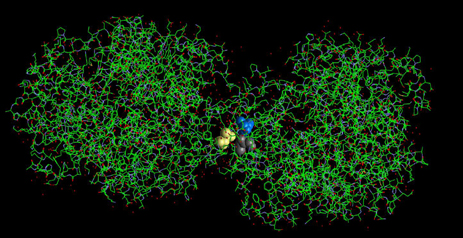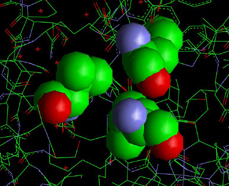Hemoglobin S Molecule - What causes Sickle Cell Anemia?

Hemoglobin S (showing Val_6, Leu 88 and Phe 85amino acids -- other exposed Val 6 not shown)
PDB FILE: 2HBS - Harrington, D.J., Adachi, K., Royer Jr., W.E. (1997) The high resolution crystal structure of deoxyhemoglobin S. J.Mol.Biol. 272: 398-407
To View the Hemoglobin S Molecule in 3D using Jsmol
Hemoglobin, also spelled haemoglobin and abbreviated Hb, is the iron-containing oxygen-transport metalloprotein in the red blood cells of the blood in vertebrates and other animals. In mammals the protein makes up about 97% of the red cell’s dry content, and around 35% of the total content (including water). Hemoglobin transports oxygen from the lungs or gills to the rest of the body, such as to the muscles, where it releases the oxygen. It also has a variety of other roles of gas transport and effect-modulation which vary from species to species, and are quite diverse in some invertebrates.
An abnormal hemoglobin in which valine has replaced glutamic acid causing the hemoglobin to become less soluble under decreasing oxygen concentrations and to polymerize into crystals that distort the red blood cells into a sickle shape. Also called sickle cell hemoglobin.
Pathophysiology Sickle-cell anaemia is caused by a point mutation in the ß-globin chain of haemoglobin, replacing the amino acid glutamic acid with the less polar amino acid valine at the sixth position of the ß chain. The Glu 6 Val mutation in deoxy-HbS favors a hydrophobic interaction between each strand and its neighbor.

Image above: The Hydrophobic Pocket of the Hemoglobin S Molecule
The interaction between Val 6 (left) on one chain of one hemoglobin molecule and a hydrophobic patch formed by Phe 85 (top right) and Leu 88 (bottom right) on a chain of another deoxygenated hemoglobin molecule leads to hemoglobin aggregation.
About the Sickle Trait
The beta-globin gene is found on the short arm of Chr. 11. The association of two wild-type a-globin subunits with two mutant ß-globin subunits forms haemoglobin S, which polymerises under low oxygen conditions causing distortion of red blood cells and a tendency for them to lose their elasticity. New erythrocytes are quite elastic, which allows the cells to deform to pass through capillaries. Often a cycle occurs because as the cells sickle, they cause a region of low oxygen concentration which causes more red blood cells to sickle. Repeated episodes of sickling causes loss of this elasticity and the cells fail to return to normal shape when oxygen concentration increases. These rigid red blood cells are unable to flow through narrow capillaries, causing vessel occlusion and ischaemia.
Sickle cell trait describes the way a person can inherit some of the genes of sickle cell disease, but not develop symptoms. Sickle cell disease is a blood disorder in which the body produces an abnormal type of the oxygen-carrying substance hemoglobin in the red blood cells. Normal hemoglobin is called hemoglobin A, but people with sickle cell disease have only hemoglobin S, which turns normal, round red blood cells into abnormally curved (sickle) shapes. Normally, a person inherits two genes (one from each parent) that produce beta-globin, a protein needed to produce normal hemoglobin (hemoglobin A). A person with sickle cell trait inherits one normal beta-globin gene (hemoglobin A) and one defective gene (hemoglobin S). People with sickle cell trait rarely have symptoms due to the condition because they also have some normal hemoglobin. However, they can pass the sickle cell trait to their children, and in rare cases, exercise-induced dehydration or exhaustion can cause healthy red blood cells to turn sickle-shaped, which can cause death. A person in whom both beta-globin genes are abnormal (they produce hemoglobin S) has sickle cell disease, which can cause serious problems. Both parents must have either the sickle cell trait or the disease itself for a child to have sickle cell disease. People who have the sickle cell trait have reduced susceptibility to malaria, due to natural selection for the heterozygote advantage. However, people with the sickle cell trait can still contract severe cases of malaria.